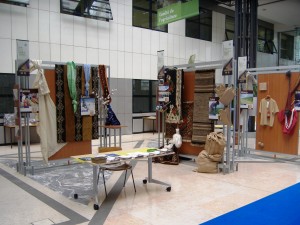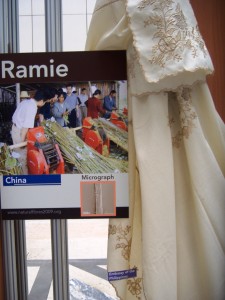- Liguria’s asparago violetto gets Slow Food treatment.
- “The bottom line is we just don’t know why they are struggling so badly.”
- Using mobile phones to treat plant pests and diseases in Uganda.
- Dingoes have positive effect on biodiversity.
- Date palm genome mapped.
- Boffins see the light, explain negative effect of fertilizers on biodiversity.
- Brogdale situation “better,” but for how long?
- Wait, Bern has a bear-pit?
Nibbles: Farmer suicides, Mexican drink
- Vandana Shiva on Indian farmer suicides.
- Make mine a tejate.
Nibbles: Sheep, Yams, Satellites, Payment for ecosystem services, Museum
- Domesticated sheep spread in two waves.
- How IITA helps yam farmers in West Africa.
- “…it is vital that we develop some sort of early warning system that will enable us to take timely action if we see part of the landscape suffering and signs of the loss of species richness.”
- First issue of newsletter on Agricultural Payments for Ecosystem Services online at Ecoagriculture Partners.
- Visit Cairo’s Agricultural Museum. If you think you can take it.
In praise of Granny Smith
Our regular readers ((And indeed Danny’s at Rurality.)) will know that there’s been a regular deluge — windfall? — of apple stories in the past few months, in particular about the imminent demise of the British orchard. The latest surfaced today. In such stories, aspersions are often cast on the qualities of such commercial favourites as the Granny Smith. ((Thanks to Dr Nelson for getting me onto this kick today, and also for a nice website about apples.)) I guess the unspoken implication is that this and similarly successful varieties are the evil spawn of some sinister multinational, and probably contain, to boot, genes cruelly extracted from some Arctic fish without its prior or informed consent and unnaturally inserted into the pristine apple genome by soulless pointy-headed boffins with Nazi sympathies.
Nothing could be further from the truth, it turns out, at least in the case of the Granny Smith, which was, in fact, spotted as a seedling and first grown by Maria Ann Smith on her farm in Ryde, New South Wales around 1868. ((As a short article in FreshPlaza alerted me, also today.)) It started life as the kind of backyard variety that would later become known as a heirloom. So, I ask myself, what obscure pome, currently languishing in some forgotten British orchard, soon to be rescued by the imminent influx of National Trust money, will eventually knock old Granny from her pedestal? And when will we be complaining about that one?
Ramie ruminations
Not a day passes that I don’t utter an imprecation — as Julian Simon Barnes did in print a few days back — at agrobiodiversity. Take yesterday. There’s a big meeting going on this week at FAO, and they’ve set up a series of stands in the atrium. Most of them are pretty boring, just piles of publications and the odd poster, but the one put up by the people behind the International Year of Natural Fibres is very nice indeed.

It has examples of handicrafts and other products made from a whole lot of different fibres, from abaca to muskox. Including ramie. And that’s when I cursed the neverending-ness of biodiversity. For what, pray, is ramie? I know abaca and muskox, but I’d never heard of ramie.

Well, it turns out to be Boehmeria nivea, a shrub in the nettle family widely cultivated in East Asia since antiquity for its bark, which is used to make fabrics. The IYNF website has a page about it. The Korean national costume (the hanbok) is made of ramie cloth, so we’re not talking about a minor, obscure, criminally underused plant here. Bloody agrobiodiversity indeed. I hate you.